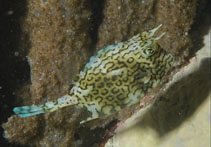| Family: |
Ostraciidae (Boxfishes) |
| Max. size: |
55 cm TL (male/unsexed) |
| Environment: |
reef-associated; marine; depth range 1 - 80 m |
| Distribution: |
Atlantic Ocean: in tropical and temperate waters (Ref. 3696). Western Atlantic: Massachusetts (USA), Bermuda, and northern Gulf of Mexico to southeastern Brazil. Reported from tip of South Africa. |
| Diagnosis: |
Dorsal spines (total): 0-0; Dorsal soft rays (total): 10-10; Anal spines: 0-0; Anal soft rays: 10-10. Dark markings on head and body; parallel bands on cheek. Pair of prominent spines projecting from in front of eyes suggests cow horns. Second pair of spines at lower rear corners of cuirass (Ref. 26938). Body deep, covered with hexagonal dermal plates (Ref. 37521). |
| Biology: |
Found in shallow water down to about 80 m, mainly in seagrass beds (Ref. 3696). Feeds on sessile invertebrates such as tunicates, gorgonians and anemones, as well as on slow-moving crustaceans, sponges (Ref. 3696), hermit crabs and marine plants (Ref. 13442). Oviparous (Ref. 205). Considered an excellent food fish; marketed fresh (Ref. 3696). |
| IUCN Red List Status: |
Least Concern (LC); Date assessed: 07 June 2011 Ref. (130435)
|
| Threat to humans: |
reports of ciguatera poisoning |
Source and more info: www.fishbase.org. For personal, classroom, and other internal use only. Not for publication.
